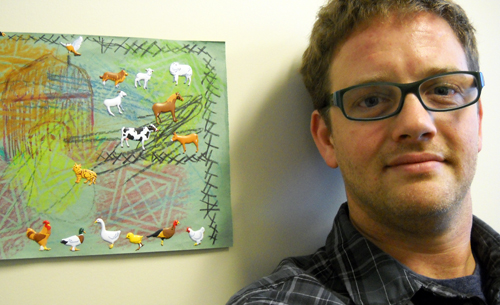
Mention greenhouse gases, and many people might think of carbon dioxide. That’s not surprising, says Dave Snider. Next to water vapour, CO2 outweighs other greenhouse gases in the atmosphere.
But it’s not the only substance behind climate change, and it’s not even the most potent. Gram for gram, nitrous oxide can cause more damage. And things stand to get worse in coming decades, says Snider.
Much of that N2O comes from nitrogen-based farm fertilizers – and will continue to do so as we look to feed a growing human population expected to peak at nine billion around 2050.
That’s just one of several reasons to look more closely at nitrogen, a chemical element that fascinates this post-doc researcher in the School of Environmental Sciences (SES).
Snider returned to Guelph in 2011 to study nutrient cycling in soil, air and water with SES professor Claudia Wagner-Riddle. Last year, he received a Banting post-doctoral fellowship from the Natural Sciences and Engineering Research Council.
He uses stable isotopes of oxygen and nitrogen to study how nitrous oxide is made and consumed. There’s an element of detective work in his studies, as he seeks out fingerprints of various forms or species of nitrogen.
It’s that shape-shifting that makes nitrogen compelling to him – and to other scientists looking at aspects of environmental and human health. Nitrates exist in water and soil. Nitrites show up in meats – hence “nitrite-free” ham. Ammonia is used in making fertilizers and many pharmaceuticals.
Nitrogen itself makes up almost four-fifths of the atmosphere. In that basic form, N2O is a stable, inert gas that we breathe in and out without effect.
From soil and air to water and rock, he says, “There’s a story about nitrogen in all those aspects.”
Soil organisms, notably cyanobacteria, have evolved to change nitrogen into a usable form. Found on and around plant roots, those organisms “fix” nitrogen, making it available for plant growth.
In the last century, we learned to mimic that activity chemically to make synthetic fertilizers, among other products. It’s the by-products of those fertilizers that have environmental scientists worried.
If farmers use too few fertilizers, they risk lower crop yields. Often, they end up applying too much nutrient to their fields. “Plants are inefficient users of nitrogen,” says Snider.
Excess nitrogen flushed from farms and industry promotes rapid growth of algae. As those organisms die and decompose, they use up oxygen in the water. That can kill other things, including fish, and even create “dead zones” in freshwater and in the oceans.
Fertilizer nitrogen also ultimately winds up in the atmosphere as N2O. There’s less of it there than carbon dioxide, but it’s much more efficient at trapping heat.
Snider doesn’t know just what percentage of atmospheric warming to link to nitrous oxide. But he says scientists have found higher concentrations of N2O in the atmosphere during the past half-century, an increase linked to human sources.
Researchers want to know more about the compound’s effects, including what might happen as we continue to apply more nutrients to soil to produce more food.
“The agricultural industry can make a big impact on reducing N2O emissions,” he says. “We need to turn around the way we manage nitrogen. We can’t allow nitrous oxide to keep increasing, we need to target on smart fertilization and give plants the nitrogen they need and no more.”
Improving nitrogen efficiency occupies other U of G researchers, including Prof. Steve Rothstein in Molecular and Cellular Biology and Prof. Manish Raizada in Plant Agriculture.
Snider is interested in basic questions about the nitrogen cycle. He hopes to learn more about how forms of the element occur and how to track it in its different guises.
He measures soil emissions at U of G’s Elora Research Station. Besides biogeochemistry, his work involves molecular and genetic techniques to look at microbial enzymes and activity.
Snider began those studies as a grad student in earth and environmental sciences at the University of Waterloo. He completed his undergrad in environmental biology at Guelph in 2003.
Both of his parents – Elaine and Meldon – are Guelph grads, and so is one sister, Heather.
Snider lives in Guelph with his wife, Andrea – a 2002 U of G grad in applied family and social relations – and their children, Olivia and Harlow.